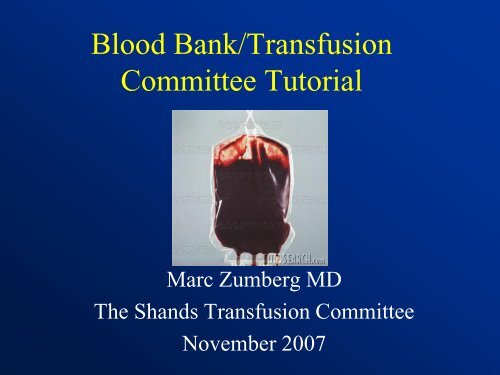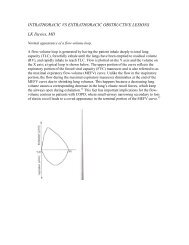Blood Bank/Transfusion Committee Tutorial
Blood Bank/Transfusion Committee Tutorial
Blood Bank/Transfusion Committee Tutorial
You also want an ePaper? Increase the reach of your titles
YUMPU automatically turns print PDFs into web optimized ePapers that Google loves.
<strong>Blood</strong> <strong>Bank</strong>/<strong>Transfusion</strong><br />
<strong>Committee</strong> <strong>Tutorial</strong><br />
Marc Zumberg MD<br />
The Shands <strong>Transfusion</strong> <strong>Committee</strong><br />
November 2007
Goal<br />
• Help us to help you:<br />
– Obtain blood necessary for surgeries and patient care<br />
– Obtain blood in a timely and efficient fashion<br />
– Obtain blood safely<br />
• By:<br />
– Ordering pre-operative type and screen (T&S)<br />
– Understanding the role of RBC alloantibodies<br />
– Ordering type and cross only when necessary<br />
– Ordering only the number of units that are needed
RED CELL TRANSFUSION<br />
Type and Screen:<br />
– Used preoperatively if transfusion is<br />
possible<br />
– Verifies ABO and Rh type of the patient<br />
and screens the patient for<br />
alloantibodies<br />
Type and Cross:<br />
– Used when transfusion is very likely or<br />
imminent<br />
– Compatible RBC units secured for the<br />
patient
Type and Screen<br />
• Tests for the presence of alloantibodies in your patients plasma against red<br />
blood cell antigens that may be found in the donated blood
Did you Know?<br />
• A T&S takes approximately 45<br />
minutes to perform<br />
• If the T&S is active a Type and Cross (ie<br />
obtaining units of PRBC) only takes about 15<br />
minutes<br />
– This may be delayed if RBC alloantibodies are<br />
noted on the T&S<br />
Result: If the T&S is kept up-to-date PRBCs can be obtained very<br />
quickly
Did you know?<br />
• Most delays in obtaining PRBC<br />
in a timely fashion are due to:<br />
– Delays in physicians writing the orders<br />
– Delays in the order getting placed into the<br />
computer system<br />
– Delays in the pick up and delivery of the blood<br />
from the blood bank<br />
– The presence of alloantibodies on the T&S<br />
• Can be prevented if pre-operative testing is done and<br />
good communication is kept with the blood bank
Keys<br />
• Communicate<br />
– With the attending physicians and members of the medical<br />
team concerning transfusion needs for planned surgeries<br />
and ongoing patient care<br />
– With the ward clerks the urgency of transfusions<br />
– With nursing and couriers if transfusion is urgent<br />
– And especially with the blood bank<br />
• Urgency of the blood product<br />
• If known alloantibodies
Problems<br />
• Preoperative Type T&S are<br />
not always ordered<br />
– In the surgery clinics<br />
– In the anesthesia pre-op clinics<br />
– On the wards<br />
• This can lead to significant delays if<br />
alloantibodies are present and the blood type is<br />
rare
Alloantibodies<br />
• Antibodies in your patient’s<br />
plasma directed against incompatible RBC<br />
antigens of the blood donor<br />
– More common in females with prior pregnancies<br />
– Anyone previously transfused
Alloantibodies<br />
• When an alloantibody is detected<br />
for the first time the blood bank will:<br />
– alert the ordering physician<br />
– Try to obtain 2 compatible units<br />
• If the alloantibody is rare then Lifesouth has to screen<br />
their stock of RBCs and rare donor registries to find<br />
compatible blood<br />
– If not available may have to be shipped in from other areas<br />
of the country<br />
Please note that alloantibodies can lead to significant<br />
delays in obtaining compatible blood products
Problem<br />
• The Crossmatch:<strong>Transfusion</strong> ratio<br />
(C:T ratio) at Shands is too high<br />
– Lots of blood is being<br />
crossmatched and never transfused<br />
– We are failing to meet JAHCO recommended<br />
standards and are at risk of citations
Why is a high C:T ratio bad<br />
• Securing blood that is never transfused is<br />
taxing on the blood bank<br />
– Non-transfused blood has to be placed back in the<br />
general inventory which is costly and time<br />
consuming<br />
– Takes time and effort away from the blood banks<br />
ability to secure blood for other cases<br />
– Replacement blood has to be ordered from<br />
Lifesouth when units are secured for Type and<br />
cross
Solutions: Maximum Surgical <strong>Blood</strong><br />
Order Schedule (MSBOS)
Solutions: Maximum Surgical <strong>Blood</strong><br />
Order Schedule (MSBOS)<br />
• Located on the back of each <strong>Blood</strong> <strong>Bank</strong> order form<br />
for preoperative blood ordering<br />
• The MSBOS is approved by the respective division<br />
chiefs of each service as the recommended units of<br />
PRBC to order for common surgical procedures
• C/T Ratio = 1.0<br />
C/T Ratio<br />
Goal is
Keys: Pre-Operative Ordering<br />
• Order pre-OP Type & Screen (T&S) during<br />
pre-surgical evaluation and lab testing<br />
– <strong>Blood</strong> can be ready in
Good Practice<br />
• Keep Type & Screen order current (every 3<br />
calendar days)<br />
• Order blood products only when<br />
transfusion is certain to keep your C/T<br />
Ratio less than 1.5<br />
(C/T Ratio = crossmatch to transfusion ratio)<br />
• Plan in advance and communicate with the<br />
blood bank for patients with antibodies to<br />
minimize delay
Goal<br />
Help the blood bank to help you<br />
obtain blood for your patients in a<br />
safe, timely, efficient, and cost<br />
effective manner



